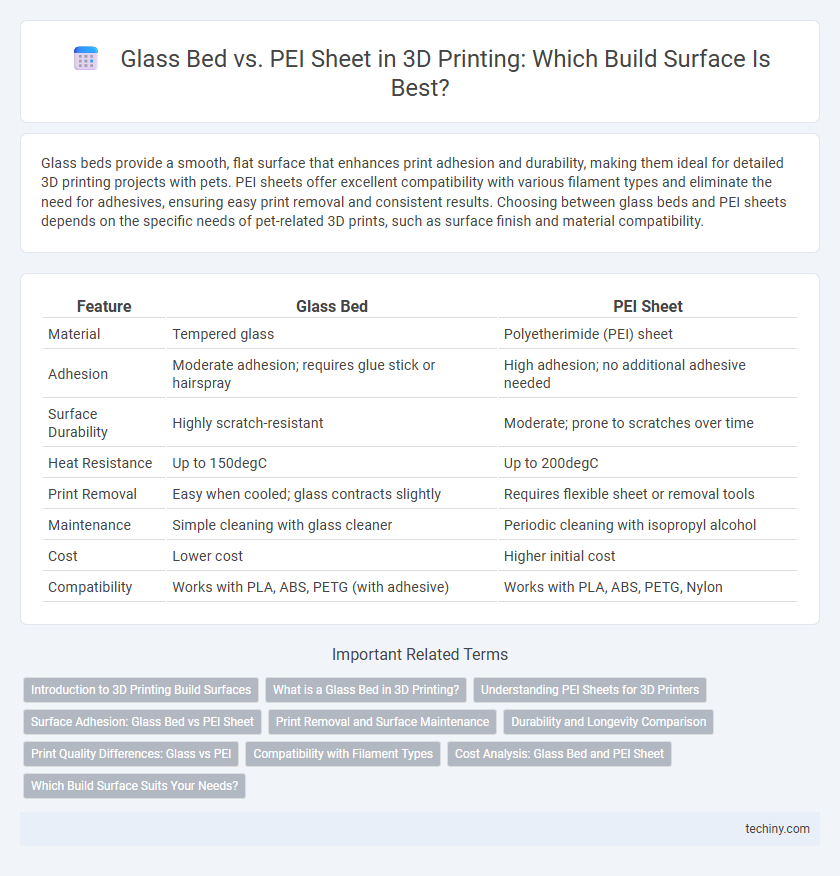Glass beds provide a smooth, flat surface that enhances print adhesion and durability, making them ideal for detailed 3D printing projects with pets. PEI sheets offer excellent compatibility with various filament types and eliminate the need for adhesives, ensuring easy print removal and consistent results. Choosing between glass beds and PEI sheets depends on the specific needs of pet-related 3D prints, such as surface finish and material compatibility.
Table of Comparison
| Feature | Glass Bed | PEI Sheet |
|---|---|---|
| Material | Tempered glass | Polyetherimide (PEI) sheet |
| Adhesion | Moderate adhesion; requires glue stick or hairspray | High adhesion; no additional adhesive needed |
| Surface Durability | Highly scratch-resistant | Moderate; prone to scratches over time |
| Heat Resistance | Up to 150degC | Up to 200degC |
| Print Removal | Easy when cooled; glass contracts slightly | Requires flexible sheet or removal tools |
| Maintenance | Simple cleaning with glass cleaner | Periodic cleaning with isopropyl alcohol |
| Cost | Lower cost | Higher initial cost |
| Compatibility | Works with PLA, ABS, PETG (with adhesive) | Works with PLA, ABS, PETG, Nylon |
Introduction to 3D Printing Build Surfaces
Glass beds offer a smooth, flat surface ideal for high-precision 3D printing, promoting excellent first-layer adhesion and easy model removal once cooled. PEI sheets provide a durable, flexible build surface with outstanding adhesion for various filament types, reducing the need for additional adhesives or tapes. Choosing between glass and PEI depends on the printer model, filament compatibility, and user preference for maintenance and print quality.
What is a Glass Bed in 3D Printing?
A glass bed in 3D printing is a flat, smooth surface made of tempered glass that provides excellent adhesion and a stable base for 3D printed objects during the printing process. It offers superior heat distribution and durability compared to other bed types, reducing warping and improving print quality. Glass beds are commonly used with adhesives or sprays to enhance first-layer adhesion and are favored for their ease of cleaning and long-lasting performance.
Understanding PEI Sheets for 3D Printers
PEI sheets for 3D printers offer excellent adhesion properties, reducing print failure rates by providing a reliable surface for various filament types. Unlike glass beds, PEI sheets maintain consistent surface texture over time, minimizing the need for frequent re-leveling or surface treatments. Their durability and ease of maintenance make PEI sheets a popular choice for improving print quality and efficiency in 3D printing.
Surface Adhesion: Glass Bed vs PEI Sheet
Glass beds provide excellent surface adhesion when heated, creating a smooth, rigid platform ideal for printing materials like PLA and ABS. PEI sheets offer superior adhesion without additional adhesives, maintaining strong first-layer bonding across various filament types, including PETG and TPU. Compared to glass, PEI sheets reduce print warping and improve print removal efficiency, making them a preferred choice for consistent surface adhesion in 3D printing.
Print Removal and Surface Maintenance
Glass beds offer a smooth, durable surface that provides excellent adhesion during printing and allows easy removal of prints once cooled, reducing the risk of surface damage. PEI sheets provide a textured finish that improves first-layer adhesion but may require regular cleaning with isopropyl alcohol to maintain optimal print removal and prevent residue buildup. Both surfaces demand different maintenance routines, with glass beds benefiting from occasional scraping and PEI sheets needing careful handling to avoid scratches and preserve their adhesive properties.
Durability and Longevity Comparison
Glass beds offer exceptional durability due to their resistance to scratches and warping, maintaining a consistent flat surface over prolonged use in 3D printing. PEI sheets provide longevity by combining durability with excellent adhesion properties, reducing the need for frequent replacements despite potential surface wear from repeated print removals. Choosing between the two depends on balancing the glass bed's unmatched flatness with PEI's versatile adhesion and ease of maintenance for extended 3D printing workflows.
Print Quality Differences: Glass vs PEI
Glass beds offer a smoother, flatter surface resulting in highly detailed prints and excellent first-layer adhesion for materials like PLA, while PEI sheets provide more consistent grip across multiple prints, reducing warping and improving print reliability. PEI's surface texture enhances adhesion for a wider range of filaments, including ABS and PETG, often leading to fewer print failures compared to glass. Glass beds may require additional adhesives or treatments to achieve comparable adhesion, but they enable easier part removal and cleaning without surface wear.
Compatibility with Filament Types
Glass beds offer excellent adhesion for PLA and ABS filaments, providing a smooth surface that reduces warping but may require additional adhesives for flexible filaments like TPU. PEI sheets deliver versatile compatibility, adhering well to a wide range of materials including PLA, ABS, PETG, and TPU without extra adhesive, enhancing print reliability and surface finish. Both surfaces perform optimally when paired with appropriate bed temperatures, with PEI sheets generally favored for multi-material printing environments.
Cost Analysis: Glass Bed and PEI Sheet
Glass beds typically cost between $10 and $30, offering a durable and scratch-resistant surface ideal for high-temperature printing. PEI sheets range from $15 to $50, providing excellent adhesion and easy print removal but may require periodic replacement due to surface wear. Choosing between them depends on balancing initial investment against maintenance frequency and print quality needs.
Which Build Surface Suits Your Needs?
Glass beds provide exceptional flatness and durability, ideal for printing with materials like PLA and PETG, offering excellent adhesion when properly prepared. PEI sheets deliver strong first-layer adhesion for a variety of filaments without additional adhesives and simplify part removal due to their slightly flexible surface. Choosing between glass and PEI depends on your printing material preferences, desired ease of bed maintenance, and frequency of print removal convenience.
Glass Bed vs PEI Sheet Infographic

 techiny.com
techiny.com